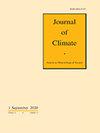热带太平洋遥感强迫驱动的十年期印度洋偶极子的形成机制
IF 4
2区 地球科学
Q1 METEOROLOGY & ATMOSPHERIC SCIENCES
引用次数: 0
摘要
摘要 在十年时间尺度上,热带印度洋在夏末秋初有一个带状的海温偶极子,称为十年印度洋偶极子(D-IOD)。D-IOD 的空间模式不同于传统的年际 IOD,它的东极位于爪哇岛附近,而不是像后者那样位于整个苏门答腊岛-爪哇岛沿岸。在这里,我们证明了 D-IOD 是由遥远的热带太平洋十年变率(TPDV)强迫和年际 IOD 的十年调制共同产生的,但其独特的空间模式和季节性主要是由前者形成的。在 8-9 月(AS),由于信风的季节性加强,TPDV 引起的沃克环流的下降支流相对于 6-7 月向西移动到东印度洋,从而刺激赤道东风异常和大洋上涌开尔文波,引起爪哇岛附近的次表层冷却。次表层冷却正好发生在气候学沿岸上升流的时间窗内,这样次表层冷异常就被平均上升流带入表层,并被平均流进一步输送到近海,形成 D-IOD 东极。次表层冷却只在爪哇岛附近产生,而不是苏门答腊岛,因为前者更靠近印度尼西亚贯通流(ITF)的出口。正 TPDV 期间减弱的 ITF 在 AS 赤道异常形成之前抑制了爪哇岛附近海面下变暖的增长,而在苏门答腊岛附近则没有观测到这种 ITF 效应。此外,D-IOD西极的变暖可能与TPDV相关风应力卷引起的赤道外罗斯比波有关。本文章由计算机程序翻译,如有差异,请以英文原文为准。
Formation mechanisms of the decadal Indian Ocean dipole driven by remote forcing from the tropical Pacific
Abstract On decadal timescales, a zonal SST dipole dominates the tropical Indian Ocean in boreal late summer and fall, called the decadal Indian Ocean dipole (D-IOD). The D-IOD has a spatial pattern different from the traditional interannual IOD, with its eastern pole located off Java, rather than the whole Sumatra–Java coasts as the latter. Here, we show that the D-IOD is generated by both the remote tropical Pacific decadal variability (TPDV) forcing and the decadal modulation of interannual IODs, but with its distinctive spatial pattern and seasonality mainly shaped by the former. In August–September (AS), due to the seasonal strengthening of trade winds, the descending branch of TPDV-induced Walker circulation moves westward into the eastern Indian Ocean relative to June–July, which stimulates equatorial easterly anomalies and oceanic upwelling Kelvin waves, causing subsurface cooling off Java. The subsurface cooling just occurs within the time window of climatological coastal upwelling so that subsurface cold anomalies are brought into the surface by mean upwelling and further transported offshore by mean flows, forming the D-IOD eastern pole. The subsurface cooling is only generated near Java but not Sumatra, because the former is closer to the exit of the Indonesian Throughflow (ITF). Weakened ITF during positive TPDV inhibits the growth of subsurface warming off Java prior to the establishment of AS equatorial easterly anomalies, whereas this ITF effect is not observed off Sumatra. Moreover, warming of the D-IOD western pole might be associated with off-equatorial Rossby waves induced by TPDV-related wind stress curls.
求助全文
通过发布文献求助,成功后即可免费获取论文全文。
去求助
来源期刊

Journal of Climate
地学-气象与大气科学
CiteScore
9.30
自引率
14.30%
发文量
490
审稿时长
7.5 months
期刊介绍:
The Journal of Climate (JCLI) (ISSN: 0894-8755; eISSN: 1520-0442) publishes research that advances basic understanding of the dynamics and physics of the climate system on large spatial scales, including variability of the atmosphere, oceans, land surface, and cryosphere; past, present, and projected future changes in the climate system; and climate simulation and prediction.
 求助内容:
求助内容: 应助结果提醒方式:
应助结果提醒方式:


